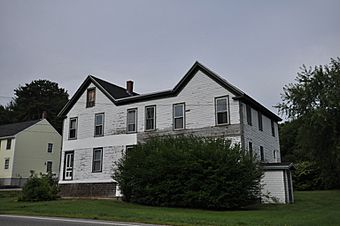Cummings' Guest House facts for kids
Quick facts for kids |
|
|
Cummings' Guest House
|
|
 |
|
| Location | 110 Portland Ave., Old Orchard Beach, Maine |
|---|---|
| Area | 0.5 acres (0.20 ha) |
| Built | 1923 |
| Architectural style | Late Victorian |
| NRHP reference No. | 04000744 |
| Added to NRHP | July 28, 2004 |
The Cummings' Guest House is a special historic home in Old Orchard Beach, Maine. It was a summer boarding house for African Americans. It opened in 1923, during a time when many places had unfair rules. These rules, called Jim Crow, meant that African Americans were often treated differently.
The Cummings' Guest House was one of the few places where African Americans could find a place to stay. Many famous musicians stayed here, like Duke Ellington, Cab Calloway, Count Basie, and Lionel Hampton. In 2004, this important house was added to the National Register of Historic Places.
A Welcoming Place in History
Rose and Edward Cummings Jr. bought the house at 110 Portland Street in 1917. They were the first African-American family to live in Old Orchard Beach. In 1923, they turned their home into a summer boarding house. It was a safe and friendly place for African-American travelers.
Why the Cummings' Guest House Was Important
Even though it wasn't listed in business guides, many people knew about it. Word spread by people telling their friends. Later, special travel guides for African-American vacationers helped too.
Many African-American performers played at the Old Orchard Beach Casino. But even though Maine didn't have segregation laws, these performers were often not allowed to stay in other hotels. The Cummings' Guest House welcomed them. Famous guests included Duke Ellington, Cab Calloway, Count Basie, Lionel Hampton, and Harry Carney. Harry Carney even became a regular visitor. The Cummings family ran the boarding house until 1993.
The House Itself
The house was built around 1870. It was likely a farmhouse at first. It's a wooden building with a style called Victorian. The house now includes the original building and a small barn. These two parts were joined together with a two-story addition.
The house used to have a porch that wrapped around two sides. This porch helped connect the different parts of the building. It has since been removed. Inside, the house has changed over the years. The kitchen was updated in the 1970s. But some bathrooms still have their original walls and fixtures from the 1920s.
In the 1960s, the business started to slow down. This was because new laws helped end unfair treatment. One of the Cummings children then moved into part of the house all year long.



